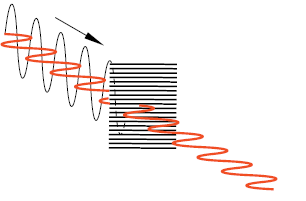Advantages of polarizing filters
A part of the emitter light in retro-reflective systems is reflected directly back to the receiver from target objects with shiny surfaces, e. g. stainless steel, aluminum or tinplate.
Simple Retro-reflective light sensors can therefore not reliably distinguish reflected light from the object and reflected light.
For this reason, Balluff retro-reflective light sensors are alternatively equipped with polarizing filters, which, together with a Balluff reflector, an optically activated prismatic mirror, form a selective barrier against the reflected light from the object, but still allow the reflector light to occur.
Light consists of a wide variety of individual beams, which all sinusoidal oscillate on their dispersal axes. A polarizing filter (fine line grid), then only the beams oscillating parallel to the grid level are let through, and the vertically oscillating ones are entirely deleted.
Of all the other oscillation planes, only the portion which consists of parallel components is allowed to pass.

